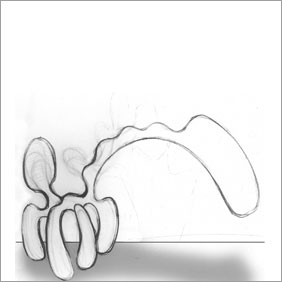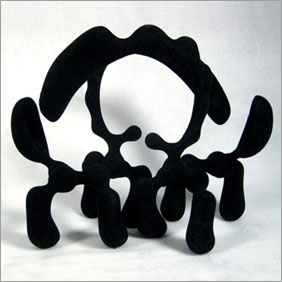

The sculpture was originally fabricated in a clear plastic resin, but as the design developed it was painted with black lacquer and then flocked. This gives the sculpture a soft quality that is very inviting. The sculpture is in two parts. The whole dimensions are 10” X 13” X 9”.
As part of the SculptCAD Rapid Artists Project, I spent 3 months learning how to use Free Form, a 3-D computer program to create sculptures. This program is very similar in mind set to the Adobe Photoshope and Illustrator programs. Like them there are multiple ways of producing the same results, which means that the instruction book lists one way, and each of the SculptCAD technicians had radically different ways of achieving the same results. In the end, I stitched together enough of the program to get the results that I wanted. Overall, The combined 3-D computer aspects and the physicality of the Phantom tools did result in the sensation of working with a physical material. It did take time to get comfortable with the visual workspace, just like it takes time for your eyes/brain to adjust to the visual world of a 3-D movie.
By the time my sculpture, Chicken Neck Johnson was ready to send to the printers I had made a few changes to the original concept. The sculpture is now smaller, and it has been duplicated, creating a pair of beasties that are engaged in a traditional beastie greeting. The sculpture is now titled Sniffing.
The original choice of materials was a water clear plastic resin that would give the sculpture the look of hand blown glass. But after 3 attempts by the printers, all the resulting sculptures were sticky and half filled with a cloudy gelatin. To resolve this, the sculptures were placed under UV lights. This cured the stickiness and hardened the interiors, unfortunately it also caused the resin to turn pink.
After some brainstorming, I decided to go in the opposite direction of cold hard crystal towards a soft fuzzy black felt. This created in a surface that absorbs the light and flattens the physical appearance of the sculptures, thus reducing the visual volume back towards a 2-D graphic world.
As I had expected, using these technology based tools did not make the creative process any “easier”. I still had to use all the traditional art tools such as form, mass, composition… Even after the sculptures were printed, there was still a lot of work to do. It’s very much like getting a bronze sculpture back from the foundry.
I have been surprised by people’s reactions to the project. When describing how this technology is used to replace missing or damaged bones, people are amazed and gob smacked. But when describing how artists are using this same technology to create sculptures, suddenly it’s proof that our culture is going down the tubes, and that soon all art will be fabricated by the simple the push of a button. As you can imagine, this has lead to long discussions on the value and nature of art, with lots of “but this” and “but that” extensions.
